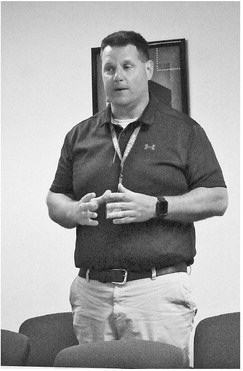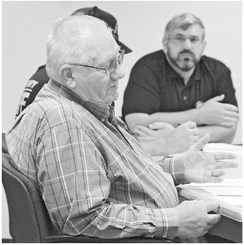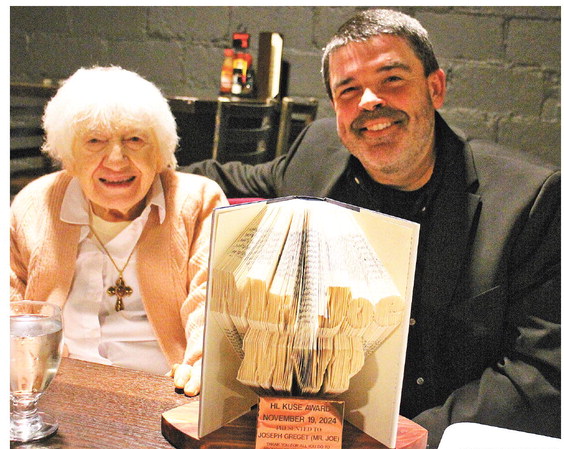County cool to contract change to increase ambulance cost


The million dollar question for rural communities across the state and nation is how to provide emergency medical services to residents without breaking the bank to do it.
At the July 14 law enforcement and emergency services committee meeting, committee members addressed two ends of that spectrum from paying a premium for critical ambulance coverage to supporting an expanded county-wide first responder network with the goal of getting boots on the ground right away at emergency scenes.
Earlier this year, the committee approved directing Aspirus regional director of emergency services Bob Kirkley to use critical staffing pay to ensure that shifts are covered particularly in Gilman and Rib Lake. Even with the premium pay, the county has seen coverage gaps with a number of shifts going uncovered across the county in May and June.
Paying a premium to ambulance crews to cover shifts has the impact of blowing up the wage portion of the service’s budget. At Friday’s meeting, committee members balked at approving an amendment for the county’s contract with Aspirus which would shift more of those wage expenses onto the county. The current contract caps the county’s costs at 45% of the budget expenses. This was written into the contract after steep increases in the county’s subsidy of the ambulance service in recent years.
In a decades-long partnership, Taylor County owns the ambulances and contracts with Aspirus to run the service. A major change in recent years has been the consolidation of licenses from each of the stations having their own to all sharing one. Kirkley explained that all three would have been unable to meet the requirements to maintain their licenses without that action. This has been perceived as “Aspirus taking over” especially in the Gilman area. In recent years recruitment and retention of ambulance crews has been hampered by COVID-era restrictions and requirements mandated by the federal government for agencies receiving Medicare and Medicaid funds. Kirkley said all those restrictions have since been lifted.
Demographics is the other factor leading to a shortage of ambulance crew personnel. Kirkley noted once-active ambulance personnel are aging out of either wanting or being physically able to take on-call shifts.
For Ray Soper, the question of if the county should pay more for the personnel costs comes down to finances and the contract language where Aspirus states it will provide coverage 24 hours a day, 7 days a week to the county.
Kirkley explained they meet that requirement, but that when there is no one stationed in Gilman or Rib Lake, a crew from Medford is called out to respond.
“You made a huge mistake last year, sorry about that,” Soper said, sticking to the point of the contract capping costs and protecting the county from unforeseen circumstance. He said the increase should be reflected in the next budget rather than this one.
“The contract says you are required to provide coverage. Now Aspirus wants to change that, that is not our fault,” said committee member Lorie Floyd. Floyd said the critical coverage was intended only until the shared agreements could be put in place with neighboring services.
Kirkley cautioned that the county cannot rely on those agreements to ensure coverage because all ambulance services across the state and nation are experiencing similar issues with recruitment and retention of crews.
“It is not feasible or fiscally responsible to have a crew 24 hours a day in Gilman,” Kirkley said, noting the county will need to decide if it wants to maintain three bases or what the system will look like in the future.
The coverage has always relied on on-call crews. In the past month, 92% of Gilman shifts were covered, 93% of Medford shifts and 85% of Rib Lake shifts. Kirkley noted they will shift personnel from Rib Lake to Gilman when there are shortfalls because of the shorter distance between Medford and Rib Lake compared to Medford and Gilman.
“What I am seeing is you aren’t fulfilling the contract,” Soper said.
Committee chairman Lester Lewis clarified that with the license being county wide there is legal fulfillment of the contract.
“We are almost doubling the budget in staffing,” Kirkley said of the impact of the premium pay.
Lewis noted that while the county sees what is charged, they never know the actual expense compared to revenue for Aspirus.
After a lengthy discussion, committee members tabled action for Aspirus to get more information to the county.
First responders
An effort spearheaded by Ashley Dake and others is looking to shorten the amount of time between when an emergency happens and when emergency care begins.
Dake is working with James Small, Rural EMS Outreach Manager, with the Wisconsin Office of Rural Health, and others to create a county-wide first responder agency.
Dake explained that the goal is not to take away from the ambulance service, but to have volunteer responders able to get to the scene and start treatment as ambulance crews are on their way and that it would be those crews transporting the patient. She said she got into emergency medical responding 12 years ago and has loved it. She said there are currently first responder groups around the county, but they are limited to the coverage area of their sponsoring departments. In her case, she is with the Stetsonville first responder group which is under the fire department there and that it means as a first responder she cannot respond outside of that fire service area. Dake said they have people in Gilman and Rib Lake who are interested in taking the course to be a first responder and that in order to go on calls they would need to have their first responder certification. The first responder course is about six weeks long as compared to the 12 week course to become an emergency medical technician and be part of the ambulance crew.
Dake said her ask to the county as this point is to be able to use the Taylor County name for their service. She said it would operate independently of the county and would run primarily on its own fundraisers, donations and grants.
“They are currently doing this at no compensation at all,” Lewis said. “I don’t see a drawback in doing this,” he said of giving the group the county’s blessing to processing.
Committee members approved giving their blessing to the new group.
Medical examiner
Medical examiner Scott Perrin was at Friday’s meeting to address concerns expressed by committee members about coverage and reporting for medical examiner calls.
The medical examiner’s office handles deaths that occur outside of a hospital setting to determine cause of death as well as signing off on cremations before they may occur.
Floyd said she had been told there were grants the county was unable to get because of not having certain reporting done. Cahoon said in getting funding for opioid- related deaths and overdoses the health department needs better reporting and, when possible, autopsies. She said she understands these are expensive and not always possible to do. She said they also need to look at older people who are on multiple medications and if there is the potential for drug interactions leading to death.
“There are very few opioid deaths in our county,” Perrin said. He said he and his deputies work with the sheriff’s department to determine if an autopsy is needed.
“We don’t do a lot of autopsies in this county,” Perrin said, noting that a lot of times there is a very clear cut reason why someone died. He said an autopsy can cost $1,500 and up to $2,500 to be done.
Likewise, Perrin said they don’t typically do lab tests to prove how someone died when most of the time they are not necessary.
“What type of money are we leaving on the table?” Floyd asked.
“I don’t know if you could put an actual number on it,” Cahoon said.
Lewis said that he was under the impression that the opioid settlement funds could only be used for prevention and treatment and did not think the county could be reimbursed for autopsy expenses. “I don’t see where we would necessitate spending that money to get more grant money,” Lewis said.
Perrin also answered concerns that had been expressed about the timeliness of medical examiners responding to death scenes. Sheriff Larry Woebbeking said that came from dispatchers and law enforcement and he has provided guidance that unless there is something more there, that they should arrange for a body to be removed and that the medical examiner will catch up on it.
“How big of a problem is this really,” Perrin asked, noting that there are three of them and that at times they are just not available. “We don’t pay anybody to be on call,” he said.
Perrin said that most cases don’t need immediate attention, noting that a death scene from an accident is a different story. Woebbeking said he feels it is important for law enforcement to remain there with family members until a body is removed.
Woebbeking offered to meet separately with Perrin to work out what they can do for responding to scenes where people have died.
Perrin also noted that Taylor County is unique in having the contact for the medical examiner up for renewal frequently. Most counties with medical examiners have an indefinite appointment with the person holding the position until they move on or retire.
The medical examiner differs from the coroner in that a coroner is an elected position for a two-year term.
“It is not feasible or fiscally responsible to have a crew 24 hours a day in Gilman.”
— Bob Kirkley regional emergency services director for Aspirus





